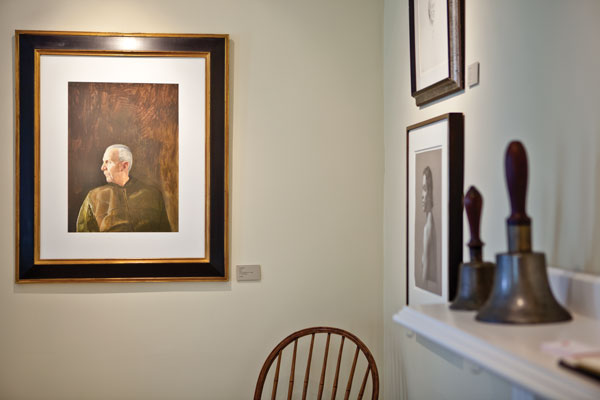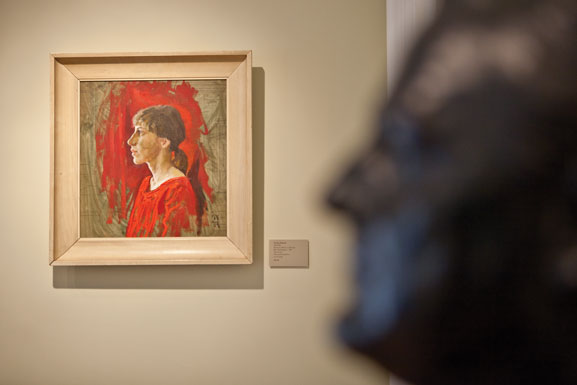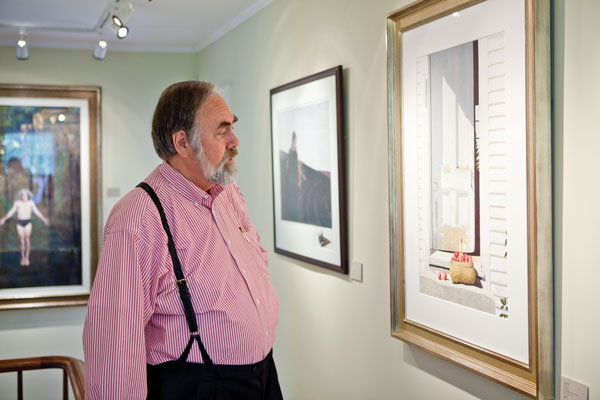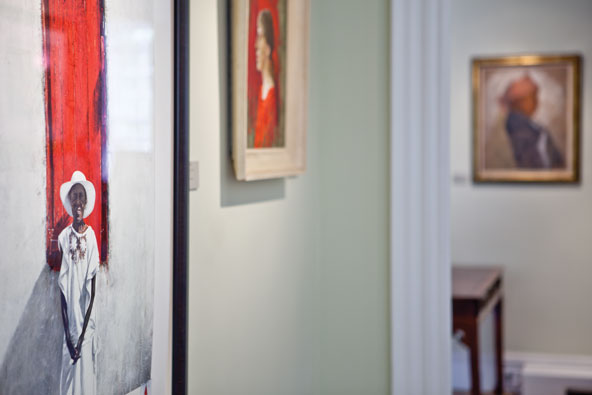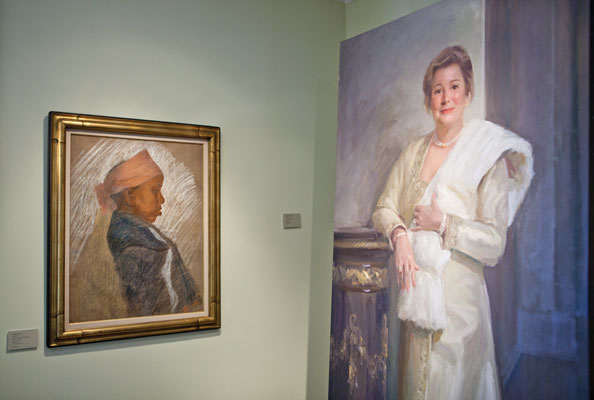Gary Haynes
PROFILE-April 2011
BY REBECCA FALZANO | PHOTOGRAPHY IRVIN SERRANO
A Portrait of American Realism Gary Haynes sought Andrew Wyeth’s Maine—and found his own
In an unassuming old sea-captain’s house on Main Street in Thomaston, Gary Haynes has created an unexpected shrine to the masters of American realism. Their works are dressed in custom frames so handsome that the frames themselves are works of art, and on this particular evening they are arranged on the gallery walls in a carefully curated exhibition. The works may number the dozens, but Haynes knows each one intimately. His affection betrays no favorites, as if they were his grandchildren. He did, after all, select each work himself, a collection so valuable in its artistic significance that it could easily be featured in one of the world’s finest museums. Haynes, a triumph of Southern gentility, greets gallery goers at the door. As they pass by each piece—a John Singer Sargent here, a Norman Rockwell there; a William McGregor Paxton; a Ruth Bernhard; a host of Wyeths—the question can’t help but materialize: How did a boy from Knoxville, Tennessee, wind up in Maine with the giants of the art world under his arm?
You can’t talk about Gary Haynes’s life without mentioning the Wyeths—Andrew in particular, whom Haynes refers to as “Mr. Wyeth,” perhaps out of habit as much as respect. To say that Haynes followed Wyeth to Maine may be a bit hyperbolic, but it’s not that far off. It would be more accurate to say that Haynes longed to see what Wyeth saw, and in doing so he came to Maine, fell in love with the state, and eventually opened a gallery down the road from the landscapes Wyeth once painted. When he was a young art student in Tennessee and an admirer of Wyeth’s work from afar, it was not the future Haynes imagined for himself. But he is certainly happy it turned out the way it did.
As a high school student, Haynes began taking private drawing lessons to learn the fundamentals. With art school in his sights, he saved up for tuition and, at nineteen, left his hometown to attend the Harris School of Advertising Art in Nashville, which specialized in commercial art. Anxious to join the workforce, he left after two years to work for the Kroger Company, where he created newspaper layouts for the advertising department. His next two jobs kept him in the ad world—first in a studio that served a large regional advertising agency, then at a mid-sized regional agency in Knoxville called Lavidge & Associates, where he worked while taking night classes at the University of Tennessee.
It was the late sixties. Andrew Wyeth had just published his first book when Haynes began taking watercolor classes under the tutelage of artist Carl Sublett, an instructor who would exert a profound influence on Haynes’s artistic path. Sublett spent time in Maine every summer and was well acquainted with Wyeth. He would come back from Maine with stacks of watercolors that Haynes devoured. “I don’t think you can be around Mr. Wyeth, the consummate realist, and not be influenced,” Haynes says. Over the course of three months, Haynes saved up one hundred dollars to buy Wyeth’s first large-format book. “I studied it like crazy. It had all these juicy, wonderful things in it that, as an artist, you wanted to learn how to do.” Haynes started following Andrew Wyeth’s work closely and, later, that of his relatives—N. C., Jamie, Carolyn, and Henriette.
As Haynes became increasingly enamored of watercolors, he started painting with colleagues on the weekends and then submitted his work to a two-person show. Over time, Haynes realized that his day job was interfering with his artistic pursuits. “I was torn between the ad business and fine art and painting and marketing my work,” he says.
Despite this, Haynes’s career continued full speed ahead. In 1975, he was hired as an associate creative director at a small but fast-growing company called Eric Ericson & Associates in Nashville. He stayed there for nearly twenty-five years, working his way up from the creative side of the business to the “business side of the business” before becoming president. He eventually bought the company and continued its resounding success in the 1990s. “I was totally consumed by the agency. But my interest in art and museums and collecting continued even though my hands had stopped drawing and painting,” he says. The success of the company and a couple of agency-sponsored venture capital deals allowed Haynes to begin investing seriously in art and building a personal collection, particularly with works by the Wyeth family.
As the business grew, Haynes began to travel more often, and in the mid-1980s he started coming to Maine. “I wanted to find the places Andrew Wyeth painted. I wanted to see them for myself—I sought his point of view, his perspective.” When Haynes got to Maine, he found it. “I saw a glorious sky, a wonderful landscape, great people,” he recalls. He began painting again.
In 1999, Haynes sold the agency and, ten years later, its historic schoolhouse headquarters, which he had converted into executive suites. Now retired, Haynes could finally focus full-time on collecting and selling art. “I had more art than I had walls, both in my home and my business.” Haynes bought another house, which is now the Franklin, Tennessee–based arm of Haynes Galleries, a private, full-service fine-art gallery specializing in American realism. The gallery, launched in 2010, also serves as a resource for collectors, offering art- and collection-management services, auction representation, even framing advice.
As Haynes settled into the gallery business, his mind returned to Maine. With the gallery’s focus on American realism and so much of the collection featuring art by the Wyeths, it seemed a natural fit for Haynes to expand his business to Maine. Haynes and his wife, Jo Anne, had bought the nineteenth-century sea captain’s house in Thomaston in 2004, and a few years later they decided to turn it into the gallery that it is today.
Haynes’s hope is that the both of his galleries will serve as places where people come not only to admire the art but to be inspired by it. “In addition to hanging the work on the walls and enjoying it, there are lessons to be learned.”
Here, in Wyeth country, Haynes has found his own Maine.
HAYNES GALLERIES:
HAYNESGALLERIES.COM
207-354-0605

